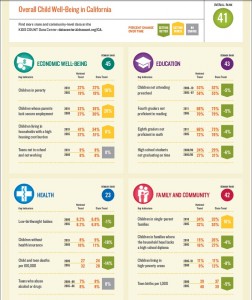California’s poor showing in a national study of children’s well-being came despite increases in academic achievement. California students improved on all four indicators in education, according to the 23rd annual Kids Count report released last week by the Annie E. Casey Foundation. 2012 Kids Count: California measures of child well-being. Source: Annie E. Casey Foundation. (click to enlarge)

Between 2005-07 and 2008-10, more children enrolled in preschool, more fourth and eighth grade students were proficient in reading and math respectively, and more high school students graduated on time. The increases ranged from four to six percent. But it wasn’t enough to lift the state above an education ranking of 43 out of the 50 states.
California fared little better in its overall score, coming in at 41 based on its performance in all four categories scored by Kids Count. In addition to education, the report examined economic well-being, health, and family and community.
The four categories are generally intertwined, so new research indicating that family income has trumped race and ethnicity as a potential cause of the education achievement gap may be part of the reason California did so poorly. Nationwide, the gap between socioeconomic level and academic achievement is “nearly twice as large as the Black/white achievement gap,” wrote Stanford education professor Sean Reardon in his study The Widening Academic Achievement Gap Between the Rich and the Poor. “That’s the opposite of what it was 50 years ago.”
Reardon said that family income is almost as strong at predicting how well children will do in school as is theirparents’ level of education.
Children living in poverty, by race, ethnicity & income. Source: American Community Surveys, 2009 and 2010. (Click to enlarge)
It’s possible that the dramatic plunge in family income due to the recession is too recent to have reversed the improvements in educational achievement from nearly two decades of major reform initiatives in the state. But Reardon sees those insidious changes coming. He found that among children born in the past 20 years, the achievement gap based on income when they enter kindergarten is two to three times larger than the achievement gap between black and white students.
The number of children living in poverty in California increased by nearly 166,000 between 2009 and 2010. More than 2 million of the state’s children are in families living on less than $22,000 a year.
“Poverty is one of the greatest threats to a child’s healthy development,” wrote Oakland-based Children Now in an overview of the Kids Count findings. “The stress associated with poverty and financial strain can negatively impact children’s cognitive development and ability to learn.”
A more powerful influence, according to Kids Count, is living in an area of concentrated poverty, defined as a community where at least 30 percent of the families are below the poverty line. In Fresno, 43 percent of children live in these areas, the fifth-highest rate in the nation. Statewide, 1.5 million children are affected, and they are disproportionately children of color. African Americans, Latinos, and Native Americans are about three times more likely than white kids to live in areas of concentrated poverty.
Fourth grade reading proficiency by race. Source: 2012 Kids Count. (click to enlarge)
“In some domains, such as Education, wide inequities among children tempered progress for all,” wrote the authors of Kids Count. “Despite perennial hand wringing about a ‘crisis in education,’ high school graduation rates and national math and reading scores for students of all races and income levels are higher than ever. Although there’s plenty of room for improvement, the overall trend is positive. However, we continue to see deep disparities in educational achievement by race and especially by income.”
Native American and African American children are nearly twice as likely as white children to have parents who don’t have permanent, full time,
year-round jobs. According to the advocacy group Preschool California, even though it’s been well documented that high-quality preschool can improve school readiness and start to level the playing field, California’s subsidized preschool program only serves 30 to 40 percent of eligible three- and four-year-olds, and just 14 percent of Latino children are in preschool programs that prepare them for success in school.
Children Now warns that unless state leaders and advocates can get together and make education a priority, the outlook is glum. “In a state like California, where Hispanic children make up the majority, disparities like these have big implications for the economic and civic future of our state.”
To get more reports like this one, click here to sign up for EdSource’s no-cost daily email on latest developments in education.